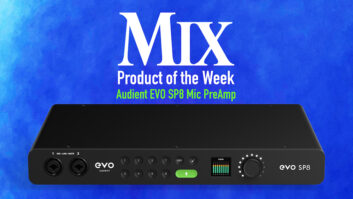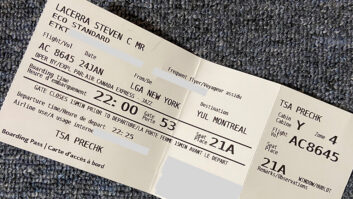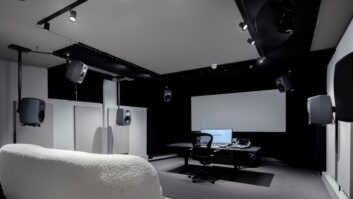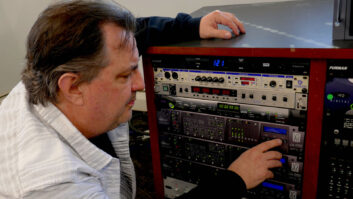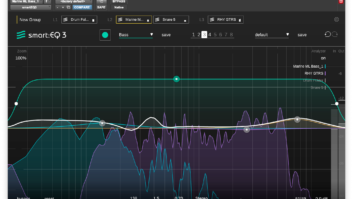There are many ways to acquire knowledge. I asked a friend who teaches audio at a community college for his perspective on audio education and received a succinct answer: “Everybody’s learning about Pro Tools, but many graduates are lacking in the fundamentals of audio, as well as music.” My thoughts on the subject are as numerous as the nooks and crannies in an English muffin.
I received a two-year EE degree back in the stone age, when tubes were still part of the curriculum and logic circuits comprised discrete transistors. At the time, I didn’t have a plan, didn’t envision a career in equipment design and considered getting a first-class radio engineer’s license but never followed through. I did want to rock ‘n’ roll, see the world, play with audio gear and know how it worked. The experience of sitting in on a session at Philadelphia’s Sigma Sound prior to graduation focused my career path on that goal of life in the studio.
In hindsight, what I learned in school was not design minutiae but the scientific method: the fundamental process of observation, variable minimization and data acquisition; the process is the same as miking a drum kit. It’s not possible to graduate knowing everything, hence the expression “continuing education.” I did not attend an audio recording school — few existed in the early ’70s — but I learned those skills while employed as a technician, always open to any technique-improving tweak (and, even now, there’s still plenty to learn). I think it’s easier to absorb the fundamentals in a calm, nurturing and organized environment, but nothing sticks with ya like learning from a mistake.
It should come as no surprise that some equipment designers do not have engineering degrees. They simply evolved into the position from the repair perspective, learning what aspects compromised a good design and using healthy dashes of tenacity, curiosity and inspiration. A few audio designers did get their parchment, but not always in electronics. Sometimes, their diverse influences are creatively reflected in the thought process. There are times when being “rigid,” as in disciplined, has its place right alongside being “open” to randomness.
When it comes to acquiring an education, the only correct answer is what’s right for the individual. I often joke that schooling and recording equipment costs are similar, so why not just buy the gear and teach yourself? But it’s not that simple. The instructors I encounter who are a part of my customer base seem knowledgeable in a variety of disciplines that I’d like to know more about. I wouldn’t mind enrolling in a few of their classes, exploring some questions and taking a concentrated chunk of time for research. My course list would include acoustics, arranging, math and MIDI refresher classes, sound for video and any opportunity to play in a musical ensemble.
CHATTING WITH DAVE
Earlier this year, I had the good fortune to bump into Crane Song designer Dave Hill at the airport. It was not only luck (we got to chat and scribble, going and coming) but by coincidence, I mentioned the topic of how to advise people on audio education. Considering the sheer volume of people who are competing for work in this business, Dave urges students to keep alternative employment in mind. For example, rather than seeking an audio-only education, Dave suggests getting a “real” degree — one that is meaningful to the rest of the world — with a minor in audio.
“All a school can do is teach the basics,” Dave said, “so if you choose an audio-only school, pick one that emphasizes real hands-on learning and problem-solving.” An audio school should be just as certified and accredited as its “legit” counterpart, including having a verifiable graduate-placement record (both upon graduation and five years down the road). Dave has seen the best and worst: Some schools were all about numbers (of students), while others went out of their way to place the students, some in high-profile studios.
AUDIO AS FASHION
Many job opportunities now exist in what was previously considered the non-audio workplace. The corporate conference room is one example of a mini-multimedia extravaganza: live presentations and documentation for later viewing/listening. Okay, so maybe it’s not your first choice, but here is a definite need for audio content in multiple formats, from the Web to removable media, radio, satellite and cable TV distribution, each an audio subculture.
Our industry has a genetic disposition to replicate — not just audio, but information — via magazines, Websites, chat rooms and message boards, all catering to the sonically obsessed. Such saturated “broadcasting” has heightened the awareness of an industry that was once quite specialized and almost hidden from the employment marketplace. (Think of the pre-digital-era film industry and its use of 35mm mag stock.) The upside is that manufacturers have responded with remarkably powerful and affordable toys (as well as with higher-priced and justifiably cool boutique gear). The downside to the toy- and desire-glut is the challenge of finding well-paid employment, hence the number of “hobbyists” who amass enough gear to start their own businesses. As a result, many more people learn in isolation without training in the basics and without mentoring. This need for information has made “looking it up on the Net” the norm — the closest thing to mentoring. A message board is a potentially great source for interactive information, as long as you know how to differentiate between misinformation and fact.
GEEK CHIC?
And then there is audio’s technical side, itself a diverse area of knowledge, although sparsely populated compared to the biz’s glam side. Entry-level positions can be as nuts-and-bolts as wiring and installation, all the way to the über-geek world of file servers and beyond. Somewhere in the netherworld is component-level repair, complete with its own niches: from big fat retro all the way down to itsy-bitsy surface-mount technology. Mechanical skills were once essential for tape machine maintenance, but that has become a rare and highly specialized skill set (see last month’s “Tech’s Files”).
TECH’S FILES CLIFF NOTES
While the fundamentals are too many to detail in these final paragraphs, here are a few essentials. Terry Hazelrig (www.diyacoustics.com) highly recommends the F. Alton Everest CD set and workbook, Critical Listening and Auditory Perception ($195.95 at www.artistpro.com). It wasn’t easy for an acoustician to prioritize listening skills over an optimized environment, but “I’ve heard excellent work done under less-than-pristine conditions — I can’t remember ever hearing the converse of this,” says Hazelrig.
Technical inclination seems more of a rarity these days. The sonically popular retro gear — which is partly due to its inherent technical simplicity — also provides a good environment in which to learn the basics. I recommend making a $500-ish investment in an oscilloscope, oscillator, soldering iron and a voltmeter, as well as reading this column. Effort in = results out, a more positive spin on “GIGO.” Between the retro-basic and computers, there’s a lot to know, a lot to learn and a world to discover.
Next month, Eddie plans to detail the past year in pictures. Visit him online at
www.tangible-technology.com
for pictures, sounds and many words.
